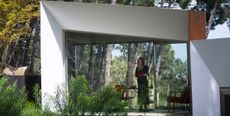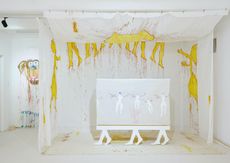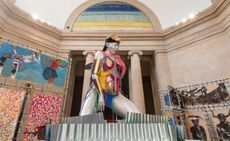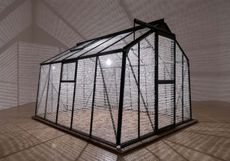Tate Britain celebrates the short but seismic age of New Brutalism

Designed in 1949 by Alison and Peter Smithson and opened in 1954, Hunstanton Secondary Modern School was a radical series of Miesian boxes landed in Norfolk; and a key building in the development of British modernism.
The team behind its construction, and the documentation of its construction, included not just the Smithsons but the sculptor Eduardo Paolozzi, who created a large collage for the school; the artist-photographer Nigel Henderson; as well as the pioneering structural engineer Ronald Jenkins of Ove Arup & Partners. The group fused, found common creative cause and continued to collaborate.
The Smithsons designed Jenkins’ office at Arup which featured a Paolozzi collage on the ceiling, a project which saw them become a cross-disciplinary collective dedicated to exploring the problems and potentials of mass media and other manifestations of modernity. The critic Reyner Banham would tag that broader project 'New Brutalism' in 1955.
In the meantime the team, now the nucleus of what was the Independent Group, also helped create the hugely influential ‘Parallel of Life and Art’ exhibition at the ICA in 1953. Tate Britain’s ‘New Brutalist Image 1949-1955’ exhibition, celebrates this short but seismic collaborative blast with previously unseen pictures by Henderson as well as plans and drawings by the Smithsons.

The staircase at Hunstanton Secondary Modern School. © Tate

Structural engineer Ronald Jenkins’ office at Arup featured a Paolozzi collage on the ceiling. Photography: Nigel Henderson. © Tate

'Collage Mural', by Eduardo Paolozzi, 1952. © The Eduardo Paolozzi Foundation

‘Plaster Blocks', by Eduardo Paolozzi, 1952. Photography: Nigel Henderson. © Tate

The interior of Henderson’s house in Bow, London. Photography: Nigel Henderson. © Tate

A portrait of Henderson's daughter in the family's front room, also decorated with designs by Paolozzi. Photography: Nigel Henderson. © Tate
ADDRESS
Tate Britain
Millbank
London SW1P 4RG
Wallpaper* Newsletter
Receive our daily digest of inspiration, escapism and design stories from around the world direct to your inbox.
-
 The new Ford Capri wants to tap a vein of Gen X nostalgia. Does it succeed?
The new Ford Capri wants to tap a vein of Gen X nostalgia. Does it succeed?We ask if the all-electric Ford Capri can capture the swagger of its much-loved but rather oafish predecessor
By Guy Bird Published
-
 Rug designer Sibylle de Tavernost’s homage to Fernard Léger
Rug designer Sibylle de Tavernost’s homage to Fernard LégerAbstract modern art, craft heritage and contemporary life fuse in Sibylle de Tavernost's new limited-edition rugs
By Harriet Thorpe Published
-
 Private gallery Stiftung Froehlich in Stuttgart stands out with an organic, cloud-shaped top
Private gallery Stiftung Froehlich in Stuttgart stands out with an organic, cloud-shaped topBlue-sky thinking elevates Stiftung Froehlich, a purpose-built gallery for the Froehlich Foundation’s art collection near Stuttgart by Gabriele Glöckler
By Hili Perlson Published
-
 Brutalism in film: the beautiful house that forms the backdrop to The Room Next Door
Brutalism in film: the beautiful house that forms the backdrop to The Room Next DoorThe Room Next Door's production designer discusses mood-boarding and scene-setting for a moving film about friendship, fragility and the final curtain
By Anne Soward Published
-
 The Turner Prize 2024 opens at Tate Britain
The Turner Prize 2024 opens at Tate BritainThe Turner Prize 2024 shortlisted artists are Pio Abad, Claudette Johnson, Jasleen Kaur and Delaine Le Bas
By Hannah Silver Published
-
 'You survive with grace': Alvaro Barrington at the Tate Britain
'You survive with grace': Alvaro Barrington at the Tate BritainAlvaro Barrington considers Black culture with Grace installed in Tate Britain’s Duveen Galleries
By Amah-Rose Abrams Published
-
 ‘Women in Revolt!’ at Tate Britain is a deliciously angry tour de force of feminist art
‘Women in Revolt!’ at Tate Britain is a deliciously angry tour de force of feminist art‘Women in Revolt!’ puts feminist art from 1970 – 1990 under the spotlight at Tate Britain
By Hannah Silver Published
-
 Cornelia Parker’s major Tate Britain survey explores British fragility
Cornelia Parker’s major Tate Britain survey explores British fragilityAt Tate Britain, Cornelia Parker’s first London survey show dissects politics and history and reframes everyday life
By Martha Elliott Last updated
-
 Turner Prize 2020 bursary winners announced
Turner Prize 2020 bursary winners announcedTen artists have been selected to win this year's historic Turner Bursaries
By Elly Parsons Last updated
-
 Photographer Leandro Farina casts a rare, cinematic light on Balfron Tower
Photographer Leandro Farina casts a rare, cinematic light on Balfron TowerWe sit down (from afar) with the London-based photographer to get his take on the past life of a Brutalist icon on the cusp of transformation
By Harriet Lloyd-Smith Last updated
-
 Frank Bowling cements his status as a modern master with Tate Britain retrospective
Frank Bowling cements his status as a modern master with Tate Britain retrospectiveAfter six decades, the British artist is finally getting his dues as a gently dazzling survey of his paintings opens in London
By Harriet Lloyd-Smith Last updated